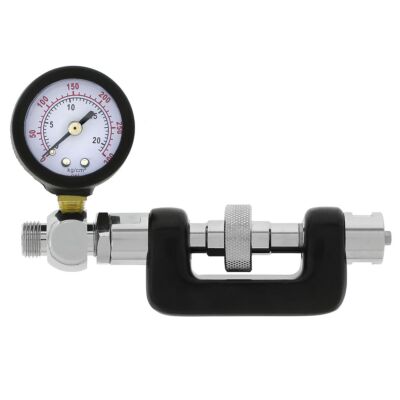Second Stage In-Line Adjusting Tool w/IP Gauge
- Fine-tune 2nd stages that have an adjustable air inlet orifice
- Connects between the 2nd stage and the LP hose
- Included gauge so IP may also be checked
- Works with most brands - has both hex and flat end tips
Second Stage In-Line Adjusting Tool w/IP Gauge
This specialized tool connects in line between the second stage regulator and the LP hose, allowing adjustments to the "cracking pressure" of your second stage. Using the included pressure gauge the intermediate pressure (IP) of the first stage may also be checked. Then a flat blade or hex key (you must have configured the tool for one or the other before pressurizing) can be inserted in the 2nd stage to allow the orifice to be turned to find exactly the proper adjustment for the second stage air inlet (A.K.A. cracking pressure). This dual tool has an 0.032 inch flat blade, screwdriver-like adjusting tip, which fits most slotted regulator orifices and also a 5mm hex key adjusting tip (just reverse the tool - watch the video above). We use this tool in our own service department and our service tech tells us the quality is excellent but notes that while this tool works with most adjustable second stages, and nearly all modern designs, it does not work with every brand of second stage.
| Brand | DGX |
|---|---|
| SKU | DX-70143 |
| Weight | 0.850000 |
Customer Reviews
 WARNING
WARNING
Most authorized dealers are able to perform warranty, repair and service work on your equipment. Availability of sub-assemblies and components, repair parts, specialized tools and maintenance manuals does not imply qualification to assemble and/or service scuba equipment. Service by other than an authorized dealer voids the warranty on all products we sell. Improper service of dive equipment can lead to serious injury or death.
Dive Gear Express recommends that divers participating in more advanced technical and exploration type diving be trained in equipment service. We recommend that non-qualified individuals seek professional training/mentoring before attempting repairs or servicing on any diving equipment.
What is the knob and lever on my second stage?
The knob and lever are used to alter the breathing characteristics of some types of regulator second stages. All our downstream design high performance second stages, including the DGX Xtra and D6, Dive Rite XT2 & XT4, MaresXR HR, and the Apeks XTX200 & XTX50 include a knob to adjust inhalation cracking pressure (aka opening effort.) Some second stages, including the DGX Xtra and D6 along with the Dive Rite XT2 & XT4 and all the Apeks XTX Series, offer a lever to disable/enable venturi assisted inhalation. The Mares XR HR/VR/SXS stages use a unique Vortex Assisted Design (VAD) system that does not require a venturi lever. Upstream designs with a servo-assist valve, such as the Poseidon Xtreme, don't normally incorporate these features because the design inherently obviates most of the need for them. Many special application designs that are light duty, such as backup (aka 'octo', 'safe second', 'alternate', 'oxygen') and BCD integrated second stages, may omit the diver adjustable cracking pressure and/or the venturi assist features for the sake of simplicity.
The knob is for diver adjustment of the cracking pressure (aka opening effort) which is the inhalation force it takes to trigger the second stage valve to open and begin to flow breathing gas to the diver. Some people might refer to this as the 'breathing resistance' but this is a misnomer because once the gas starts flowing, adjusting the cracking pressure during inhalation will have minimal effect. On most high performance designs turning the knob all the way out (counter clockwise) will cause a slight hiss or dribble of free flowing gas and turning it all the way in (clockwise) will make it difficult to breathe from the regulator. Start by setting the knob in the middle of the adjustment range and then turn the knob to set the cracking pressure to your personal preference. Some divers will occasionally adjust it during the dive based on changes in their physical effort and depth, but most divers find a setting they like and never feel a need to change it. †
Many high performance second stage designs include a venturi assist feature that reduces breathing resistance by automatically increasing gas flow during inhalation. Regulators with the venturi assist enabled are prone to free flow if the second stage is not in the mouth. The venturi lever set in the pre-dive position (-) will substantially eliminate the tendency to free flow. Second stages in pre-dive mode WILL deliver breathing gas, but with some increased breathing resistance because the venturi assist feature has been disabled. On the primary second stage, you should push this lever in to the dive position (+) when you put the regulator in your mouth. On second stages not in the mouth during the dive the switch remains in pre-dive position; should circumstances require its use while in-water, once breathing from the regulator just switch the lever from pre-dive to dive mode.
The knob and the lever have related yet different functions, the knob determines how easy it is to start the breathing gas flowing to the diver and the lever determines how easy it is to maintain the breathing gas flow. Some lever designs are {predive| dive} with little or no range of adjustment to the venturi effect, however the adjustment knob by design always has a significant range of settings. Both can be set to minimize the possibility of free flow.
Some divers (especially those who use a breathing pattern called 'skipping') incorrectly believe that by using the adjustments to decrease the regulator performance they will conserve gas. In fact, improperly adjusted second stages have the opposite tendency to cause most divers to retain CO2 and increase their respiration rate thus gas usage while at the same time causing some discomfort and/or headache.
† You might be surprised to learn some experienced divers dislike having an adjustment knob on their second stage. They view the knob as an unnecessary option that is thought to be more of an entanglement hazard, certainly adds to the cost of the regulator and some just prefer a more streamlined second stage. Unnecessary? Yes, even when there is no external knob, the cracking pressure on downstream designs is always adjustable internally. This an easy skill to learn, beneficial to know, and there are videos on the internet to show you how.






